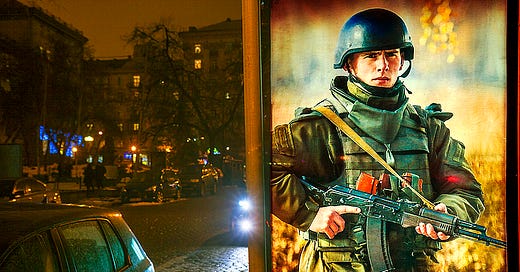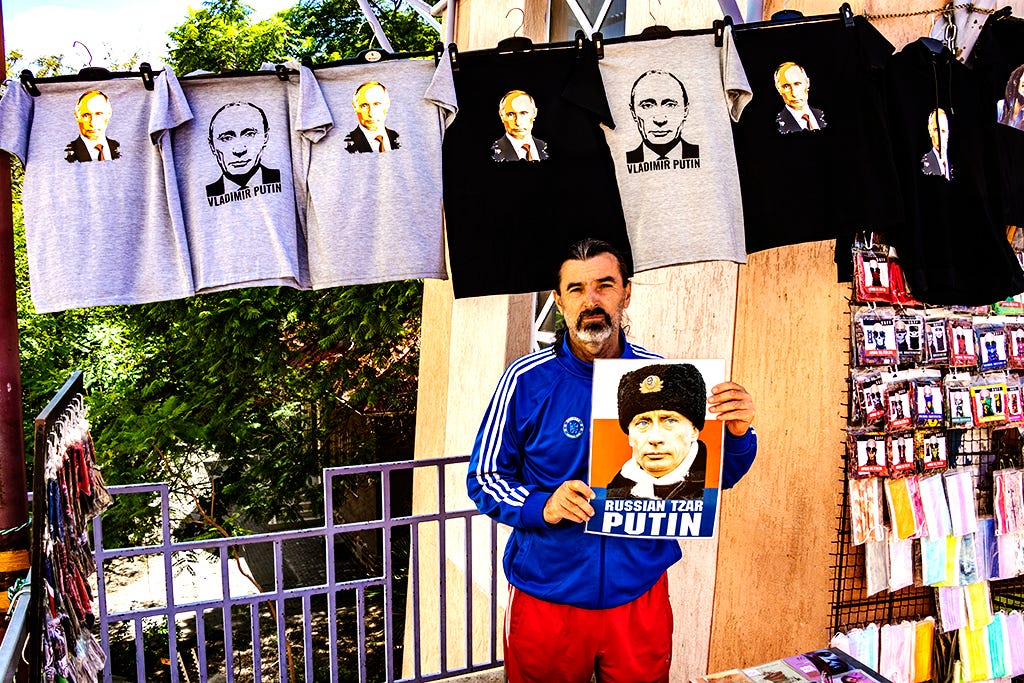[Kiev, 2/13/16]
For about two years, my blog had a reader who commented often, but nearly always with slogans, cliches or cartoony logic. When I pointed out that Europe’s problem with Muslim refugees would be solved if the Jewjerked West would stop destroying Muslim countries, she indignantly replied, “In any war, the men must stay and fight, and the women must stay to help them!”
Europe’s Muslim refugee problem, then, can’t be blamed on Israel, Uncle Sam or NATO, but on their terrified victims, for fleeing the Jewjerked West’s bombs and bullets!
Before Syria was attacked, it was a haven for Iraqi refugees. Though regularly sabotaged or attacked by Israel, Lebanon still houses 1.5 million refugees from Syria, Palestine and Iraq. Before Libya was destroyed, it attracted thousands of Africans from other countries. The Jewjerked West leads the world, by far, in generating refugees.
More than corpses or maimed bodies, war creates refugees, and we’re seeing it, again, with Russia’s invasion of Ukraine. A week into this war, a million Ukrainians have already fled to other countries, and this number would be much higher without the Kiev government’s policy of turning back, and conscripting, all Ukrainian men aged between 18 and 60.
In Kiev, many of those who remain have sought shelter in its unusually deep subway system. A glance at such scenes shows many men hiding with their women, for they’re not bare-chested Rambos, each brandishing an AKM rifle with an extra phallic M203 grenade launcher, ready to mow down hundreds of Russians. If Sylvester Stallone was in Kiev, he’d undoubtedly be curled up inside Arsenalna Station, at 347 feet underground the deepest in the world. That’s 32 stories down! Why take chances?
Now, let’s just use common sense to examine why a man might not rush to war. If he has, say, three children, their survival is his top priority. Thinking likewise, his wife begs him to take them all somewhere safe, so even if he doesn’t mind dying in battle, he must decisively remove his family from danger as soon as possible, and survive to take care of them.
If he loses his sight, mind, limbs or loin as a soldier, he won’t just be useless to them, but a tremendous liability for decades. In his wife’s mind, this daunting fact tempers her patriotism.
Since fleeing involves risks and complications, many will hesitate or simply balk, with sometimes disastrous results. Not wanting to lose their home, they may end up bloodless and open eyed under its beams and bricks. A child, though, may survive as an orphaned vegetable.
There’s a reason why most armies depend on barely adult men, with fewer familial responsibilities and lots to prove. Though seemingly well drilled, most can’t dependably ejaculate under fire, however, for they can’t overcome their instinctive horror of killing a fellow man.
A French colonel, Ardant du Picq (1821-1870), was the first to point out that most soldiers would not kill, so consult his Battle Studies: Ancient and Modern Battle, first published in full in 1902. S. L. A. Marshall’s Men Against Fire (1947) is also seminal, but above all, read Dave Grossman’s On Killing: The Psychological Cost of Learning to Kill in War and Society, from 1996.
Muscular yet often poetic, On Killing reveals there are actually very few cool killers among us, because “killing is a private, intimate occurrence of tremendous intensity,” and more irreversible than any act, so most men just won’t do it, no matter how spiteful, angry or mean they may be. Drawing out and rationing their hatred, they’ll stop short of spilling entrails. Check out these passages from On Killing:
A threatened baboon or rooster who elects to stand its ground does not respond to aggression from one of his own kind by leaping instantly to the enemy’s throat. Instead, both creatures instinctively go through a series of posturing actions that, while intimidating, are almost always harmless.
When the fight option is utilized [among animals of the same species], it is almost never to the death. Konrad Lorenz pointed out that piranhas and rattlesnakes will bite anything and everything, but among themselves piranhas fight with raps of their tails, and rattlesnakes wrestle.
When a man is frightened, he literally stops thinking with his forebrain (that is, with the mind of a human being) and begins to think with the midbrain (that is, with the portion of his brain that is essentially indistinguishable from that of an animal), and in the mind of an animal it is the one who makes the loudest noise or puffs himself up the largest who will win.
Prior to World War II it had always been assumed that the average soldier would kill in combat simply because his country and his leaders had told him to do so and because it was essential to defend his own life and the lives of his friends. When the point came that he didn’t kill, it was assumed that he panicked and ran.
During World War II U.S. Army Brigadier General S. L. A. Marshall asked these average soldiers what it was that they did in battle. His singularly unexpected discovery was that, of every hundred men along the line of fire during the period of an encounter, an average of only 15 to 20 “would take any part with their weapons.” This was consistently true “whether the action was spread over a day, or two days or three.”
[…] General Crook’s men fired 25,000 rounds at Rosebud Creek on June 16, 1876, causing 99 casualties among the Indians, or 252 rounds per hit. And in the French defense from fortified positions during the Battle of Wissembourg, in 1870, the French, shooting at German soldiers advancing across open fields, fired 48,000 rounds to hit 404 Germans, for a hit ratio of 1 hit per 119 rounds fired. (And some, or possibly even the majority, of the casualties had to have been from artillery fire, which makes the French killing rate even more remarkable.)
Lieutenant George Roupell encountered this same phenomenon while commanding a British platoon in World War I. He stated that the only way he could stop his men from firing into the air was to draw his sword and walk down the trench, “beating the men on the backside and, as I got their attention, telling them to fire low.” And the trend can be found in the firefights of Vietnam, when more than fifty thousand bullets were fired for every enemy soldier killed. “One of the things that amazed me,” stated Douglas Graham, a medic with the First Marine Division in Vietnam, who had to crawl out under enemy and friendly fire to aid wounded soldiers, “is how many bullets can be fired during a firefight without anyone getting hurt.”
The weak link between the killing potential and the killing capability of these units was the soldier. The simple fact is that when faced with a living, breathing opponent instead of a target, a significant majority of the soldiers revert to a posturing mode in which they fire over their enemy’s heads.
Indeed, the history of warfare can be seen as a history of increasingly more effective mechanisms for enabling and conditioning men to overcome their innate resistance to killing their fellow human beings.
With the current situation in Ukraine, there’s the additional, and decisive, factor of futility, because no matter how selfless or valiant Ukrainian soldiers may resist, they will lose to Russia. Plus, there’s the doubt they’re fighting for Ukraine at all.
Nakedly exposed, young Ukrainians are goaded by cynical old men, most of them foreign. Sick, they salivate over upcoming shots of smoldering corpses in this, Uncle Sam’s latest snuff film.
[Windhoek, 3/1/22]





Hello everybody, just a quick note to say I appreciate all your comments. I do read them all. OK, time to think about the next article. I just read about Russian cats being banned from competitions by the Fédération Internationale Féline, and Russian athletics being kicked out of the Paralympics. We're sinking deeper and deeper into madness. Shooed from lame olympics, Russian cripples hobble home.--Linh
Very excellent observation. Ah, the numbers game! The numbers don't add up. We still do not understand war. That's only recently been discovered, of course, because now we can use computer simulations. So if we type in 55,000 bullets fired and only 404 casualties, the computer model shows that most soldiers couldn't aim. Or they were too afraid to kill. We don't know.
Case in point, if we simulate a clash of 1000 English knights against 1000 Scottish clansmen, the spook is over in 5 minutes. In the simulation!
Yet such battles in reality took the entire day. This suggests that in real battle, man against man, something else happens that we were not shown by Hollywood movies. There was a lot of posturing and wrestling, running and hiding, taking breaks and so on.
Also, the typical 'rampage' as depicted in movies, were the hero kills ten opponents sideways while looking for the boss fight... is completely insane. This never happens.
A single physical fight is so exhausting that the body literally collapses and needs serious rest. In historic battles, there were often many advances and retreats. And when fire weapons came along, battles could last for days and weeks.
There is so much more discoveries. For example, the commanders stay in the back, right? But why? Because if they would lead, nobody would follow. NOBODY. So, the commanders must stay in the back and shoot everybody who deserts or retreats.
If you don't have such control mechanisms, like in chaotic Vietnam, you literally send out soldiers into the jungle who pretended to fight and shoot the bamboo and returned to base, exhausted, later that night. Meanwhile, the real enemy casualties resulted from strategic bombing and airstrikes and chemical weapons.
Also interesting. If men are generally reluctant to kill a fellow human being, 1% - 5% are psychopaths who don't care. And this is what researchers found. About 50% of all soldiers never saw the enemy. 35% had enemy contact, but no kill. Only a minority of 15% actually reported to have shot someone (they thought, many just lied or bragged). Of those, at most 5% were real killers of man, and they accounted for most of enemy casualties.
By the way, no soldier could ever outperform a tank or jet fighter when it comes to body count. But we never hear about them in the movies. It's not romantic.
Every war movie we see is probably a lie.